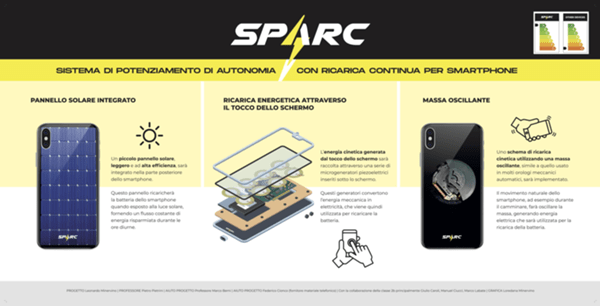What are sustainable technologies and why do they matter
Sustainable technologies are the best response to challenges of the future. Learn more about their applications and take a look at SPARC, a continuous smartphone charging system designed by a group of Viterbo students.
Sustainability is a fundamental principle for building a balanced and lasting future for our planet. This certainty is, however, accompanied by the realization that the acceleration of technological innovation has, on the one hand, led to extraordinary progress and, on the other, to the intensification of environmental challenges. Indeed, not all technology is sustainable, and today rethinking the way we develop, produce, and use it is imperative to ensure the well-being of the planet and future generations. Sustainability, in fact, is no longer an option but rather a crucial necessity that must be increasingly integrated into every aspect of our lives, allowing it to influence our daily choices as ordinary citizens, the corporate policies of our companies, and the policy decisions of our governments.
Through this lens, we will explore how technology, when designed and implemented sustainably, can become a driving force for the balance between innovation and responsibility. Then, we will take a closer look at SPARC, an interesting project presented this year at Maker Faire Rome by a group of students with their eyes on the future.
Sustainable technologies
Sustainable technology refers to that which is designed with the principles of sustainability in mind. A device that falls under this term must therefore be environmentally friendly, economical and, just as important, socially responsible. Today, creating a strong relationship between sustainability and technology is crucial and, more often than not, involves harnessing a powerful ally for the challenges of the future. There are many examples of how technology can be designed with sustainability in mind. Here are a few:
- Plant-based alternatives to meat. We took a closer look at the need to switch to more sustainable habits in food in this article. Intensive poultry farms release about 52 million tons of carbon dioxide into the atmosphere each year. According to the FAO, this is about 3 percent of human-caused greenhouse gas emissions. Awareness of the issue is growing, as is the demand for plant-based products, even prompting major food groups to develop dedicated lines or use new technologies to produce it.
- Artificial intelligence and Big Data. Optimizing, refining and making current processes and dynamics efficient is what technologies like these are for. Thanks to data analytics, the cloud and AI, humans can now learn about reality in an entirely new way, making it easier to detect flaws, weaknesses and strengths in any human dynamic: from processes to products, social phenomena to the habits of individuals. This will help make our world better and more sustainable.
- Smart buildings. One of the main culprits of global warming is carbon dioxide, and this also comes in large part from our buildings being outdated and inefficient, not only for energy class, but also in the design stages. The production of concrete and cement release a large amount of CO2 into the atmosphere. In this field, the creation and use of new technologies can significantly reduce emissions or even turn buildings into veritable purifiers, incorporating harmful carbon dioxide and integrating it in newer ways.
- Agriculture 4.0. The application of technologies such as sensors, drones and remote monitoring systems in precision agriculture supports the more efficient use of resources. These solutions, which we discussed in detail in this article, reduce the use of water, fertilizer and pesticides while improving productivity and reducing the environmental impact of farming practices.
- 3D printing. 3D printing is another example of how technology can reduce waste and the environmental impact of manufacturing. The use of recyclable materials and the ability to create customized products with less waste make 3D printing a promising technology for sustainability in manufacturing.
SPARC: when smartphones recharge themselves sustainably

SPARC is a range-enhancing system with continuous charging for smartphones.
The project, which is the work of II B students at the Technical Technological Institute of Viterbo, perfectly represents the concept of “sustainable technology” and affects us all because it focuses on a simple, everyday gesture such as charging one’s smartphone. However, the students’ proposal is different from traditional methods and is driven by the smart use of technology to recharge the battery of one’s cell phone, without even realizing it. In this specific case, SPARC takes advantage of two different sources of energy:
- Solar
- Kinetic
How exactly? To start, a high-efficiency solar panel built into the back of the smartphone captures solar energy during daylight hours, ensuring a constant flow of power. Then, touching the specially designed screen generates power through piezoelectric microgenerators placed underneath, further charging the battery. Finally, a kinetic charging system uses an oscillating mass, similar to that of automatic mechanical watches, to generate electricity during the normal movement of the smartphone. All you have to do is walk and it charges! This combination of innovative techniques results in a significant extension of battery life, reducing the need for frequent recharging and making smartphones more sustainable.
The idea behind SPARC is as bold as it is revolutionary. Through its multi-source charging approach, the project represents a concrete solution to reduce the environmental impact of our daily actions. It can be called a bottom-up project, because it was conceived and designed by a group of students who understood how important it is to use technology and their own creativity to bring sustainable solutions to life. The project is a necessary change and a concrete solution that shows how innovation and technology can achieve something great when guided by sustainability.
Maker Faire Rome – The European Edition has been committed since its very first editions to make innovation accessible and usable to all, with the aim of not leaving anyone behind. Its blog is always updated and full of opportunities and inspiration for makers, makers, startups, SMEs and all the curious ones who wish to enrich their knowledge and expand their business, in Italy and abroad.
Follow us on our social channels (Facebook, Twitter, Instagram, LinkedIn, YouTube) and subscribe to our newsletter: we promise to let just the right content for you to reach your inbox.



















































































